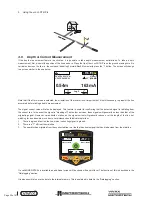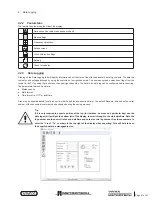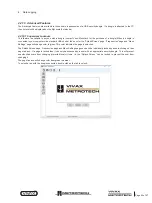
™
Page 34 of 67
3 Using the vLoc3 RTK-Pro
3.10 Sonde Location Mode
A Sonde is typically used for locating non-metallic pipes or ducts, and the camera end of a sewer inspection camera. Low-
frequency versions (512Hz/640Hz) can transmit through some metallic pipes such as cast iron pipes – which is why they are
frequently used with sewer inspection cameras.
Sonde screen icons:
67.2
25dB
8kHz
4G
2
2
3
4
5
6
8
7
1
1
Peak signal detector
2
Signal strength bar graph
3
Sonde icon
4
Null point
5
Direction to sonde
6
Frequency selection
7
Numeric signal level (mirrors the bar graph)
8
Gain setting
A Sonde is a transmitting coil, the signal radiates in a different manner than that of a line.
Null Points
Due to this construction, the sonde gives a different “Peak” pattern note that there are three distinct peaks – a small peak – a
large peak – a small peak with two “Nulls” between the peaks. The sonde is located under the center of the “large peak”
The vLoc3 RTK-Pro detects the presence of the two “Null” signals and also the position of the main “Large Peak”. It uses this
information to provide a reliable and efficient method of sonde location.
Method
1. Insert the activated sonde into the pipeline. Push the sonde about 10 – 12 Feet (3-4m) into the pipe.
2. Switch on the vLoc3 RTK-Pro and use long presses on the Return key until the sonde screen appears.
3. Press the “f” key to select the sonde frequency being used.
4. Hold the locator vertically and stationary with the tip on the ground.
5. If the locator is within the range of the sonde the screen will appear similar to the one below with an arrow pointing in a
particular and steady direction. The bar graphs either side of the screen are identical and give an indication of the signal
strength. Use the + and – keys to alter the receiver gain to keep the signal within the limits of the bar graph.






























